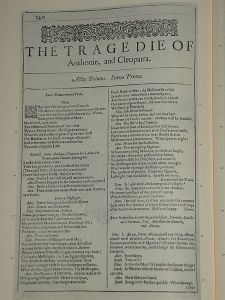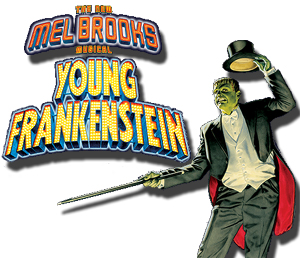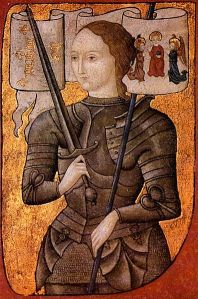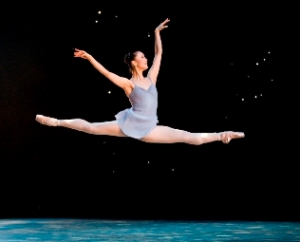Archive for category events
Phoenix arts events for Oct. 16 and 17
The newly renovated Herberger Theatre Center in downtown Phoenix feels both more comfortable and somewhat more elegant than before. Most of the change is in the lobby and to the outside of the building. The exterior is now emblazoned with the names of the three companies resident there: Arizona Theatre Company, Actors Theatre, and Center Dance Ensemble. Today and tomorrow (Oct. 16 and 17) you can check out the first and third of those. ATC is doing Backwards in High Heels: The Ginger Rogers Musical in the larger theater, while Center Dance is opening its season in the smaller one.
For its season-opening concerts, titled New Beginnings, Center Dance will present a number of local modern and contemporary companies alongside performances by its own dancers – an annual service that avails you the opportunity to sample a variety of Valley dance troupes for the cost of one ticket and a single evening. Also promised is a restaging of the first work Center Dance ever performed at the Herberger. Hmmm….
Conductor-composer Warren Cohen and his soprano wife Carolyn Whitaker have relocated to the New York area to be with their prodigious son, Graham, who recently became the youngest student in the pre-college division of The Juilliard School. But Warren has not given up on Musica Nova, his ambitious grouping of orchestras in the East Valley. He’s back this weekend to conduct an intriguing program called “Compromised Voices” (Sunday, Oct. 17, 4 p.m.) at Musica Nova’s new home, the Scottsdale Center for the Arts. Anyone who values finding new gems in the more obscure corners of symphonic repertoire will value Musica Nova.
– Ken LaFave
Events for the weekend of Oct. 8-10, 2010
Above: DESERT DANCE THEATRE’s KARATECHOP
Think there’s no culture in the Valley of the Sun? Then you haven’t been paying attention.
For instance, you live in a great place for contemporary dance. ASU’s dance program has spun out a lot of small local companies, which in turn have attracted small companies from other cities to come visit and perform here. One annual celebration of Valley dance culture is the Arizona Dance Festival, put together by the folks at Desert Dance Theatre. Its 2010 edition rolls out this Friday and Saturday night (Oct. 8 and 9) at the Tempe Performing Arts Center; click here for info or call 480-962-4584.
The festival presents different groups each night. A list of company names indicates the tempting variety of styles:
Friday – Chaos Theory Dance, CONDER/dance, Desert Dance Theatre, Dulce Dance Company, Germaul Barnes/Viewsic Expressions Dance, Movement Source Dance Company, Moving Arts Dance, Nannette Brodie Dance Theatre, Step’s Junk Funk, Yumi La Rosa.
Saturday – Anca Mihalcescu, Arathi School of India Dances, Astarte Belly Dance Company, Beauvais Ballet, Chaos Theory Dance, Desert Dance Theatre, Dias Dance Life, Dulce Dance Company, Instinct Dancecorps, Nannette Brodie Dance Theatre, Scorpius Dance Theatre, Step’s Junk Funk.
There’s also opera this weekend. Some people think all the operas have already been written, but new ones are coming out all the time, including one by composer Kirke Mechem on the classic Moliere comedy, Tartuffe. Alas, professional opera companies are among those who think all the operas have already been written – ironic, ain’t it? – so it falls to ASU’s Lyric Opera Theatre to stage this work Saturday night and Sunday afternoon. For more information, click here.
My composition teacher Ned Rorem used to pounce on any mention of Fred Astaire with the comment, “Ginger was better. She had to do everything backward and in high heels.” I have no idea if Ned’s comment had anything to do with the show opening Arizona Theatre Company’s new season this weekend, but the title is: Backward in High Heels. And yes, it’s about Ginger. Click here for info.
Also opening this weekend (at Broadway Palm Dinner Theatre in Mesa) is Sugar, the musical based on the classic film comedy, Some Like it Hot. It’s one of those shows I’ve never seen, because I love the movie so much I’ve been fearful the stage adaptation would fall short. This week I intend to cast my fear aside and check it out. Click here for more info.
– Ken LaFave
Seinfeld in Phoenix: The truth about Nothing
As all fans of the New York Four know by now, Jerry Seinfeld will be in Phoenix this week, appearing Friday night at the Dodge Theater.
That’s the truth – but not the truth about Nothing. For Nothing long ago landed in Phoenix. Yes, sad to say, Jerry and the gang found themselves homeless after their cruel incarceration and fled subsequently to that oasis for the disowned and disempowered: Phoenix, Arizona.
Don’t believe me? Click here.
Waiting hundreds of years for a premiere…
Posted by kenlafave in commentary, events on October 2, 2010
ANTONY AND CLEOPATRA – coming soon to Arizona
Last weekend, listening to Shakespeare’s Henry VI trilogy in the form of Southwest Shakespeare’s single-shot condensation, Blood Royal, I pondered the fact these words had never before been spoken on a stage in Arizona.
Director Jared Sakren had announced prior to curtain that Blood Royal constituted the Arizona premiere of Henry VI. He then added that the company’s upcoming Antony and Cleopatra (slated for spring) would also be an Arizona premiere.
We somehow have the idea that everything “classic” has been done, that the great plays, operas and symphonies have received their exposure to all willing audiences. Not true. Not, at least, in Arizona.
George Bernard Shaw, for example, is grossly underproduced. Southwest Shakespeare recently brought us Pygmalion and Arms and the Man, and Arizona Theatre Company (ATC) once did a Candida. Saint Joan, Major Barbara, Heartbreak House – these have never been staged, so far as I can tell. Ibsen goes pretty much by the wayside as well. ATC did Ghosts about a decade back, and someone must have done A Doll’s House – right? But I can find no record of The Wild Duck or Enemy of the State having been produced here.
We’ve had an opera company for over 30 years, so all the major Mozart operas have been done, one might reasonably assume. (We’re not counting obscurities like Lucio Silla.) But no. When Arizona Opera stages Abduction from the Seraglio in the spring, it will be the Arizona premiere of that sparkling comedy. We’ll have to wait a little longer, I guess, for Idomeneo.
The list of symphonic scores never performed locally is too long to print. But it will soon be at least two scores shorter, courtesy conductor Warren Cohen’s Musica Nova group. Musica Nova’s upcoming season will include the Arizona premieres of Bruckner’s Symphony No. 6 and the Violin Concerto No. 2 of Shostakovich.
We often complain we don’t get enough new art, and I would second that emotion, adding that one can’t get enough new art. But it seems we could use a lot more of the old, too.
– Ken LaFave
Golijov’s Phoenix: A world premiere
Osvaldo Golijov’s long-awaited new work, commissioned for The Phoenix Symphony by the folks at The Musical Instrument Museum, turned out to be a slow, meditative, color-drenched piece about 12 minutes long (an estimate – I didn’t time it) notable for its use of electronics in dialog with ancient instruments. Symphony music director Michael Christie conducted the premiere Thursday night; the concert repeats Saturday night.
The composition, logically enough titled Phoenix, started with the eerie sound of the kamancheh, or Persian fiddle (played by Kayhan Kalhor), sounding a Middle Eastern-tinged melody echoed and altered by electronics (Jeremy Flower on a laptop). At length, percussion (Jamey Haddad, helped by two members of the Symphony percussion dept.) began to tap out an 11-count rhythmic pattern (1-2/3-4/5-6/7-8/9-10-11). Suddenly an accordion (Michael Ward-Bergeman) took up the melody, supported by the strings and low-lying flutes of the Symphony. The rest of the piece consisted of the main melody tossed about and embroidered by these forces until at last the kamancheh intoned a quiet close.
The challenge in writing for a mix of traditional instruments and Symphonic ones is that the expressive modes of each differ widely from those of the other. There are various ways of overcoming this. Lou Harrison, in his Pipa Concerto (played by the Phoenix Symphony a couple seasons back) decided to let each “side” have its way, and underline the contrast. Golijov has chosen instead to let the traditional instruments boldly paint the stage with their bright timbres and distinctive gestures, while placing the orchestra in a strictly background role.
It would be interesting to witness an entire season of such work, and the ways in which different composers faced the challenge.
– Ken LaFave
From the stage to the screen…no, wait, reverse that!
Posted by kenlafave in commentary, events on September 23, 2010
Time brings reversals, in the arts as everywhere else, and the new season at ASU Gammage underlines one of the more radical reversals on Broadway in my time.
Of the seven shows scheduled for ASU, two are old favorites: Fiddler on the Roof (1964) and Hair (1967). In keeping with the series’ extraordinary ability to bring us the latest from Broadway, the other five are more recent shows: Young Frankenstein; Billy Elliot The Musical; Shrek The Musical; 9 to 5: The Musical; and Mamma Mia!
All but one of the five is a musical based on a hit movie, and the fifth, Mamma Mia!, is a jukebox musical, a show put together from pre-written songs.
Both things barely existed until about 15 years ago. Now, they dominate new musicals. To be sure, shows that don’t fit those profiles still get done: Avenue Q, Light in the Piazza and Spring Awakening are three brilliant examples from the past decade. But musicals such as The Wedding Singer and Dirty Rotten Scoundrels simply would never have been produced had they not enjoyed instant audience recognition of their titles, and Jersey Boys and Rock of Ages trade wholly on the popularity of songs already drilled into theatergoers’ ears.
It used to be that musicals started on stage, became movies, and along the way provided popular music with the majority of its material. Now musicals follow rather than lead, tagging along after screen hits or grabbing pop songs for support.
Familiar stories and familiar songs are, frankly, a cheap way to do instant marketing. While that doesn’t necessarily mean the resulting product lacks merit, compare Wedding Singer and Dirty Rotten Scoundrels to Light in the Piazza and Spring Awakening and a case begins to gel for originality over rote adaptation. Easy commercial paths never lead to artistic success. Imagine someone telling Lenny Bernstein and Jerry Robbins in 1957: “Dump this West Side Story thing – do a show on Gone With the Wind!”
The Broadway series at ASU Gammage opens Monday with Young Frankenstein, with songs by the man who gave us one of the biggest of all movies-into-musicals, The Producers. Mel Brooks is a funny guy and some of his songs for The Producers hit home (though none hit like the original movie’s blockbuster, “Springtime for Hitler”). It’ll be interesting to hear what his score does for Young Frankenstein.
In the spirit of combining musicals based on hit movies with the idea of the jukebox musical, I suggest the following shows for future production:
The Godfather, featuring songs from the catalogue of Frank Sinatra. Imagine the Don’s big finale, “My Way.”
Animal House, with songs by Chuck Berry, Buddy Holly, Jerry Lee Lewis and Little Richard. Think “Great Balls of Fire” and the John Belushi character; a perfect fit.
Silence of the Lambs, with a score comprising various ‘80s hits. The bad guy sings “Me So Horny.”
No Country for Old Men, incorporating Johnny Cash songs. How could one possibly improve on Anton Chigurh singing “Ring of Fire”?
– Ken LaFave
Shakespeare vs. Joan of Arc
Posted by kenlafave in commentary, events on September 18, 2010
Southwest Shakespeare’s Blood Royal, a one-evening adaptation of Shakespeare’s Henry VI trilogy, includes among its characters Joan of Arc. I plan to attend Blood Royal this week, and I look forward to seeing how the adaptation treats her, as The Maid of Orleans appears in Part One of the Bard’s original, not as an heroic figure, but as a conniving witch — a partisan of Evil France against the just reign of Good Ol’ England.
It’s only natural Shakespeare would have taken the part of his own country against her age-old nemesis. But it must be difficult today, given centuries of Joan-adoration, to portray her as anything other than a brave and holy warrior of mystical stature. More than a hundred novels have been written on her life, including one by, of all unlikely authors, Mark Twain. “She is easily and by far the most extraordinary person the human race has ever produced,” Twain wrote – amazing words from cynical old Sam Clemens. Verdi and Tchaikovsky both composed operas about her, though no one does them any more, and even this year, Rhode Island composer Steven Jobe unveiled his operatic take on the subject.
Joan is the subject of many hundreds of visual portrayals, none of them accurate, since the only painting she sat for has been lost. Southwest Shakespeare’s publicity claims their Joan is “beautiful,” though there’s every reason to believe she was as plain as an ill-fed peasant girl of that era must have been. (The image above is pure conjecture by an artist working in 1485, decades after her death.) And of course there are movies, including the 1957 lemon with Ingrid Bergman looking ridiculously pretty in clunky plate armor, and a recent made-for-TV biopic for which those responsible should be burned at the stake. Figuratively speaking.
The best film by far is Carl Theodor Dreyer’s silent masterpiece, The Passion of Joan of Arc (1928), in which a mannish, anguished Joan doubts everything save the persistence and ultimate truth of her own inner vision. It is that vision which got her killed by the Church in the 15th century, and that selfsame vision which got her made into Saint Joan of Arc by the Church five centuries later. Just a matter of perspective, I guess.
– Ken LaFave
Welcome to 2010-2011
Highs are still registering over 100 degrees Fahrenheit in the shade (which is, I am sad to tell you, where highs are measured – highs in the sun are typically 130-plus) and already the Phoenix performing arts season is at flood, with The Phoenix Symphony revving up its classics concerts, Southwest Shakespeare and Phoenix Theatre in the middle of runs, and Ballet Arizona and ASU Gammage gearing up to start before the end of September.
The common wisdom among Arizona arts presenters is that anything prior to November or after April is begging for empty seats, what with the Snowbirds still in Wisconsin, Michigan, etc. Fortunately, the common wisdom is being challenged.
The Phoenix Symphony opened its season with a concert version of The Music Man last week, and commences its classics series proper with two great warhorses this week (Thursday, Sept. 16). The Brahms Violin Concerto and Tchaikovsky’s Symphony No. 6 (“Pathetique”) are the sort of pieces we hear in our sleep, so it will be up to TPS music director Michael Christie and violin soloist Augustin Hadelich to wake us up to beauties inherent in the scores, but not necessarily heard before.
I haven’t seen it yet, but everything I’ve heard from trusted friends about Phoenix Theatre’s production of Noises Off tells me it’s something I need to see before it closes this Sunday. Stiff competition comes, however, from ASU School of Music, where Sunday (Sept. 19) at 2:30 p.m., clarinetist Robert Spring gives his annual fall recital, intriguingly titled “Speak of the Devil” and including both new scores and a score or so of Spring’s ASU colleagues. Spring and guests — including flutist Elizabeth Buck, violinist Katie McLin and pianist Andrew Campbell — will perform a sonata by Saint-Saens and a bunch of new works, including one that requires two clarinetists each to play two clarinets at the same time. (Should one call this a duet or a quartet?)
And what, in the name of Francis Bacon, is Blood Royal? That’s a question rhetorical, since we know what it is: It’s Southwest Shakespeare’s adaptation of the Bard’s Henry VI trilogy into a single evening’s tale. Does it work? I have until Sept. 26 to find out.
Ballet Arizona grabs new fans every September with its “Ballet Under the Stars” program, concerts given outdoors in Valley parks. Fresh from triumph in Washington D.C., over the summer, Ballet Arizona presents this free series beginning Sept. 22 at various locations. ASU Gammage brings Broadway to the Valley Sept. 27-Oct. 2 with Young Frankenstein, the Mel Brooks musical based on his film. The ASU season combines new shows – others include Shrek: The Musical and Billy Elliot – plus revivals of old faves such as Fiddler on the Roof and Hair.
Enough to get you started? An embarrassment of riches, as the French say – though I suspect they say it in French. Hang on, the season only gets richer, busier, and more varied.
– Ken LaFave





Here and there in Phoenix arts
Posted by kenlafave in commentary, events on November 13, 2010
In The Next Room, or The Vibrator Play
Contrary to every review of it I’ve read, Sarah Ruhl’s In the Next Room, or The Vibrator Play, is not about Victorian mores and the treatment of women. It’s about how we – now as in the past – closet sex away and treat it, not as in integral part of our lives, but as something “in the next room” – literally in the play, figuratively in the play. The Actors Theatre production of the hit comedy, an Arizona premiere, ends its highly successful run this weekend, with last shows tonight (Nov. 13) and tomorrow.
There are many poetic moments in the script, brought out wonderfully by the production. The one that touched me most personally was when the character Mrs. Givings points out it is the “unfinished” woman, the incomplete female, who most deeply attracts a man. Exactly! (How’d she – I mean the playwright – know that?)
***
The use of surtitles for Arizona Opera’s recent production of The Pirates of Penzance prompts the question, “Do we really need to see the words as well as hear then, when the words both heard and seen are…English?” It’s standard practice, I know, for operas in English to receive sub- or surtitles, the reason supposedly being that operatic singing is not conducive to being understood. But it seemed odd-nigh-ridiculous for a Gilbert and Sullivan piece, with its emphasis on the humor of Gilbert’s clever rhymes, to have the words appear above the action in advance of their being heard.
For instance, in “A Modern Major General,” the general’s famous rhyme for “strategy” appeared a good ten seconds before the singer delivered it, stepping on the joke. (Yes, I know most of us already know what the rhyme is – that’s not the point.) I’m of a mind to try to ignore the surtitles for Arizona Opera’s upcoming production of Carmen, as I imagine many who know the opera well are also inclined to do. Would that Arizona Opera’s titles were not so IMPOSING, writ large as they are. Too bad Arizona Opera hasn’t the money to do what Santa Fe Opera does: provide titles on the back of the seat in front of you, with the option of turning them off.
***
The Balinese gamelan is one of the most mesmerizing aural experiences available on the globe. Our own Musical Instrument Museum (MIM) will present a rare opportunity to hear this consort of bells, chimes and gongs in concert Sunday and Monday, Nov. 14 and 15. If you haven’t taken the time to view the MIM yet, combine a visit with this concert. I guarantee you won’t soon forget it.
– Ken LaFave
actors theatre, arizona opera, MIM, the vibrator play
2 Comments